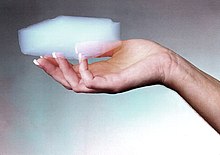Supercritical drying
The supercritical drying is a physical method for the controlled and accurate separation of liquids from solids. As with freeze-drying , the phase behavior of a substance is used to avoid drying by means of evaporation or evaporation. The term supercritical refers to the pressure and temperature conditions that are above the critical point in the process .
The process is used in manufacturing processes in microsystem technology , for drying spices and in the production of, among other things, aerogels using the sol-gel process . Samples for scanning electron microscopy , especially biological samples, are dried in such a way as to avoid the formation of artifacts that can occur during other drying processes.
Thermodynamic basics
Every substance has a phase behavior determined by its phase diagram , that is, a tendency to change its phase under certain conditions . The conditions under which such a phase transition occurs are clearly determined in the case of pure substances by pressure and temperature. For supercritical drying, the phase transition from a liquid to a gas is decisive, which is precisely what this process is supposed to avoid. Such a phase change, known as evaporation , results in the destruction of fine-pore structures due to the increase in surface tension and the associated effect of the capillary forces . But if you want to dry very delicate structures with around 75% porosity, you have to avoid this process.
Problem of subcritical drying
If the solvent is allowed to evaporate or evaporate in an oven at room temperature, a number of effects occur which prove to be problematic in the case of very finely structured materials. The solvent begins to evaporate on the surface and leads to a shrinkage corresponding to the volume of the solvent, especially in the case of gels. At the same time, solvent flows in from inside the body. The unstable fine structures are deformed and, in extreme cases, the pressure gradient that acts leads to cracks in the material. Finally, if the network is too stiff to shrink any further, the pores begin to empty, starting with the largest. The larger the pore radii and the smaller their differences, the lower the likelihood of destruction of the fine structure. Diffusion processes take effect when the pores are closed. The liquid film on the walls of the pores remains the longest. In the case of a gel, the result of such a process is a xerogel ; for example, the destruction of the smallest components.
Procedure
The basic principle is that the substance is first transferred from the liquid to the supercritical state and then the pressure is transferred to the ambient pressure at a constant temperature. In contrast to subcritical drying and freeze drying, a phase boundary is not passed, since it is not possible to differentiate between gas and liquid. In contrast to subcritical drying, there are therefore no capillary forces.
The fluids carbon dioxide and freon are particularly suitable for the process , although the latter is no longer available. Nitrous oxide has properties similar to carbon dioxide, but in its supercritical state it is a powerful oxidizer . Depending on the critical temperatures of the solvent, a distinction is made between “hot” (organic solvents) and “cold” (carbon dioxide) supercritical drying. The high demands on the equipment technology with over 250 ° C and 5 to 8 MPa and the possible changes to non-heat-resistant dry goods have made supercritical drying with carbon dioxide at 31 ° C and 7.375 MPa the dominant standard process.
However, carbon dioxide is not miscible with water or ethylene glycol , but only with methanol , ethanol or acetone . Particularly in the production of aerogels using the sol-gel process , this results in complex processes to replace the original precursor solvent with, as a rule, acetone. This diffusion-based exchange depends on the size of the body to be dried and takes eight hours with a thickness of 10 mm.
The acetone is then exchanged for liquid carbon dioxide in an autoclave at 8 ° C and around 60 bar . After repeating this step several times until the acetone has been completely removed, the autoclave is brought over the critical point of carbon dioxide and held there for one hour. The pressure is then reduced via a valve until the ambient pressure is reached and the material to be dried can be removed.
Historical
A first description of the process comes from the early 1930s by Steven Kistler (Samuel Stephens Kistler; 1900–1975).
literature
- SS Kistler: Coherent expanded aerogels and jellies . Nature, 127, pp. 741ff. (1931), ISSN 0028-0836
- SS Kistler: Coherent expanded aerogels . Journal of Physical Chemistry, 36 (1), pp. 52-64 (1932), ISSN 1520-6106
- Markus Meyer: Synthesis and characterization of novel silica gels. (Dissertation from the University of Bayreuth) GCA Verlag Herdecke 2004, ISBN 3-89863-169-9 (main source)

